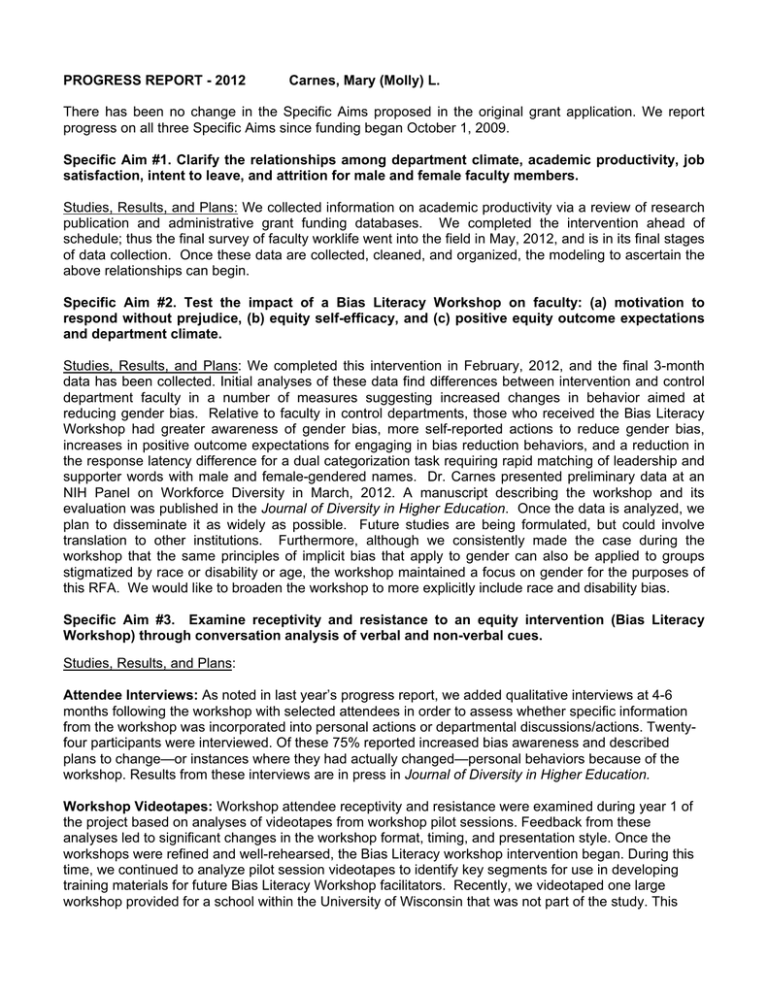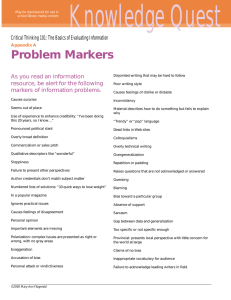PROGRESS REPORT - 2012 Carnes, Mary (Molly) L.
advertisement

PROGRESS REPORT - 2012 Carnes, Mary (Molly) L. There has been no change in the Specific Aims proposed in the original grant application. We report progress on all three Specific Aims since funding began October 1, 2009. Specific Aim #1. Clarify the relationships among department climate, academic productivity, job satisfaction, intent to leave, and attrition for male and female faculty members. Studies, Results, and Plans: We collected information on academic productivity via a review of research publication and administrative grant funding databases. We completed the intervention ahead of schedule; thus the final survey of faculty worklife went into the field in May, 2012, and is in its final stages of data collection. Once these data are collected, cleaned, and organized, the modeling to ascertain the above relationships can begin. Specific Aim #2. Test the impact of a Bias Literacy Workshop on faculty: (a) motivation to respond without prejudice, (b) equity self-efficacy, and (c) positive equity outcome expectations and department climate. Studies, Results, and Plans: We completed this intervention in February, 2012, and the final 3-month data has been collected. Initial analyses of these data find differences between intervention and control department faculty in a number of measures suggesting increased changes in behavior aimed at reducing gender bias. Relative to faculty in control departments, those who received the Bias Literacy Workshop had greater awareness of gender bias, more self-reported actions to reduce gender bias, increases in positive outcome expectations for engaging in bias reduction behaviors, and a reduction in the response latency difference for a dual categorization task requiring rapid matching of leadership and supporter words with male and female-gendered names. Dr. Carnes presented preliminary data at an NIH Panel on Workforce Diversity in March, 2012. A manuscript describing the workshop and its evaluation was published in the Journal of Diversity in Higher Education. Once the data is analyzed, we plan to disseminate it as widely as possible. Future studies are being formulated, but could involve translation to other institutions. Furthermore, although we consistently made the case during the workshop that the same principles of implicit bias that apply to gender can also be applied to groups stigmatized by race or disability or age, the workshop maintained a focus on gender for the purposes of this RFA. We would like to broaden the workshop to more explicitly include race and disability bias. Specific Aim #3. Examine receptivity and resistance to an equity intervention (Bias Literacy Workshop) through conversation analysis of verbal and non-verbal cues. Studies, Results, and Plans: Attendee Interviews: As noted in last year’s progress report, we added qualitative interviews at 4-6 months following the workshop with selected attendees in order to assess whether specific information from the workshop was incorporated into personal actions or departmental discussions/actions. Twentyfour participants were interviewed. Of these 75% reported increased bias awareness and described plans to change—or instances where they had actually changed—personal behaviors because of the workshop. Results from these interviews are in press in Journal of Diversity in Higher Education. Workshop Videotapes: Workshop attendee receptivity and resistance were examined during year 1 of the project based on analyses of videotapes from workshop pilot sessions. Feedback from these analyses led to significant changes in the workshop format, timing, and presentation style. Once the workshops were refined and well-rehearsed, the Bias Literacy workshop intervention began. During this time, we continued to analyze pilot session videotapes to identify key segments for use in developing training materials for future Bias Literacy Workshop facilitators. Recently, we videotaped one large workshop provided for a school within the University of Wisconsin that was not part of the study. This session, which incorporated all of the final changes to the workshop content, is our primary source for the training videos since it contains material that is representative of the polished workshop (i.e., it captures non-pilot interactions rather than the pilot interactions that we used in year 1 to refine the workshop). The videotapes from this session are being used to develop anonymized video clips that will accompany a training manual currently in development (see below). For this final videotaped workshop, we used three cameras and multiple microphones, making the ultimate edited products more amenable to production and anonymization of participant identities. We have selected and clipped segments from each camera. Segments were selected based on: 1) feedback from the workshop facilitators and the ethnographer who observed the intervention workshops, and 2) sound and visual quality. The clips will be anonomized ("cartoonized") to protect the identities of the participants, and integrated with the training manual as part of the dissemination phase of this project. Facilitator Training Manual: A training manual is under development based on our experiences with the workshop. Crucial information is gleaned from the videotapes, the observer’s field notes, attendee interviews, a list of frequently-asked questions, and lecturer responses to challenging discussions. To date, each slide has been annotated with complete lecture notes as well as references for relevant research studies. A section delineating recommendations for trainer skills, trainee recruitment strategies, and workshop logistics (e.g., venue, seating arrangements, materials, timing, etc.) is in progress. As stated above, an accompanying video is being “cartoonized” so that future trainers can watch snippets of a workshop in progress without compromising the confidentiality of the attendees. HUMAN SUBJECTS All IRB approvals were renewed for another year.


